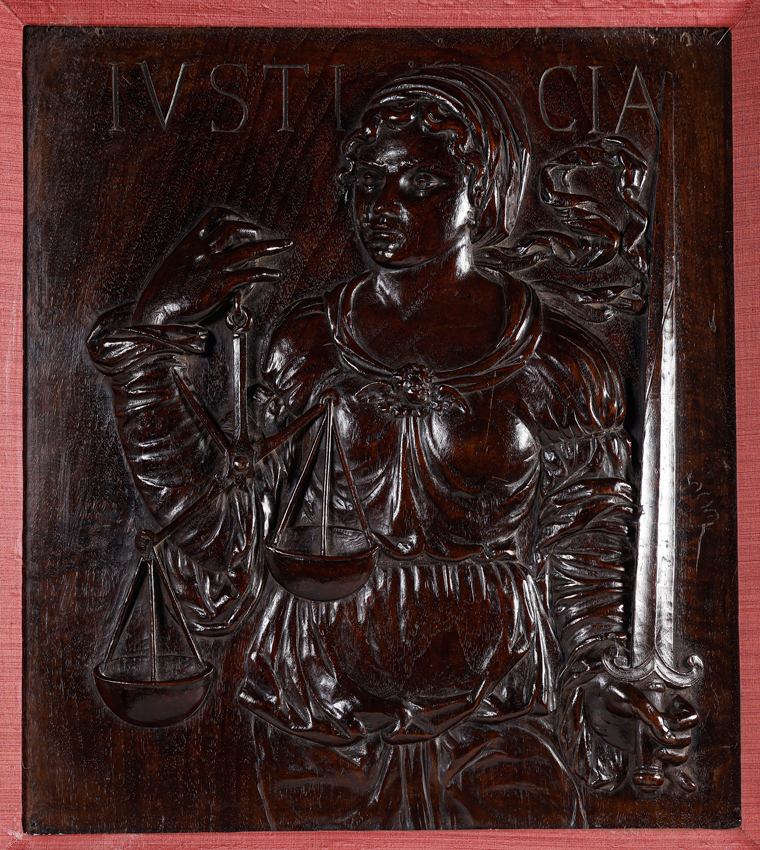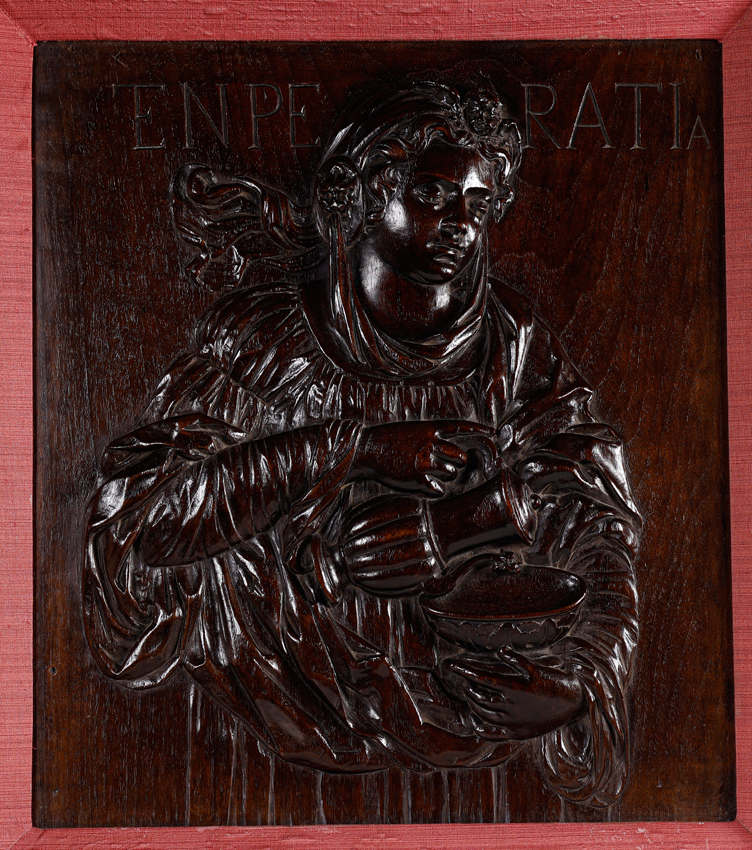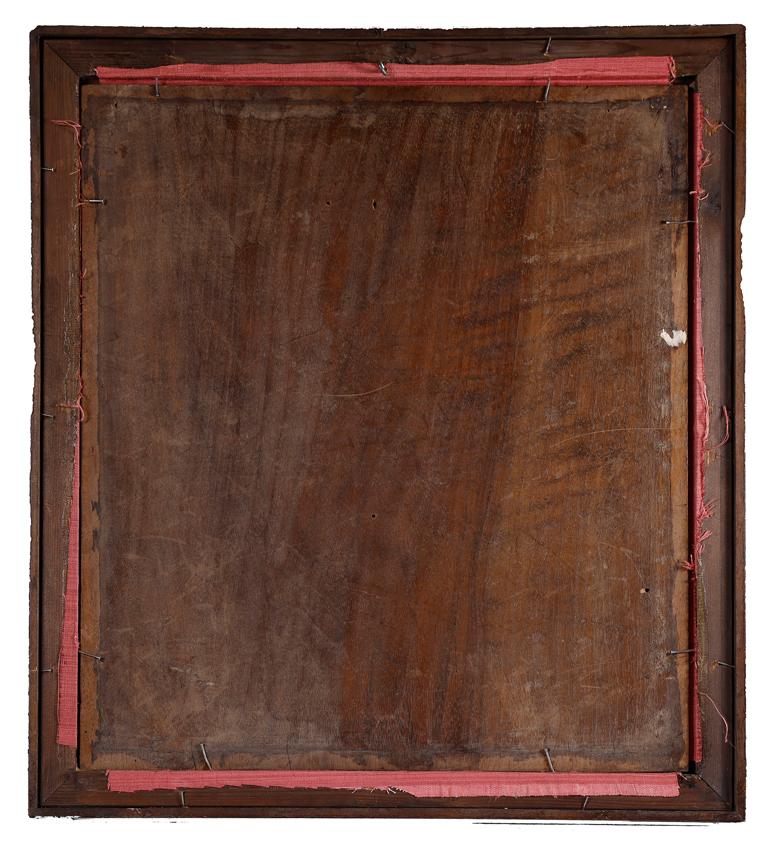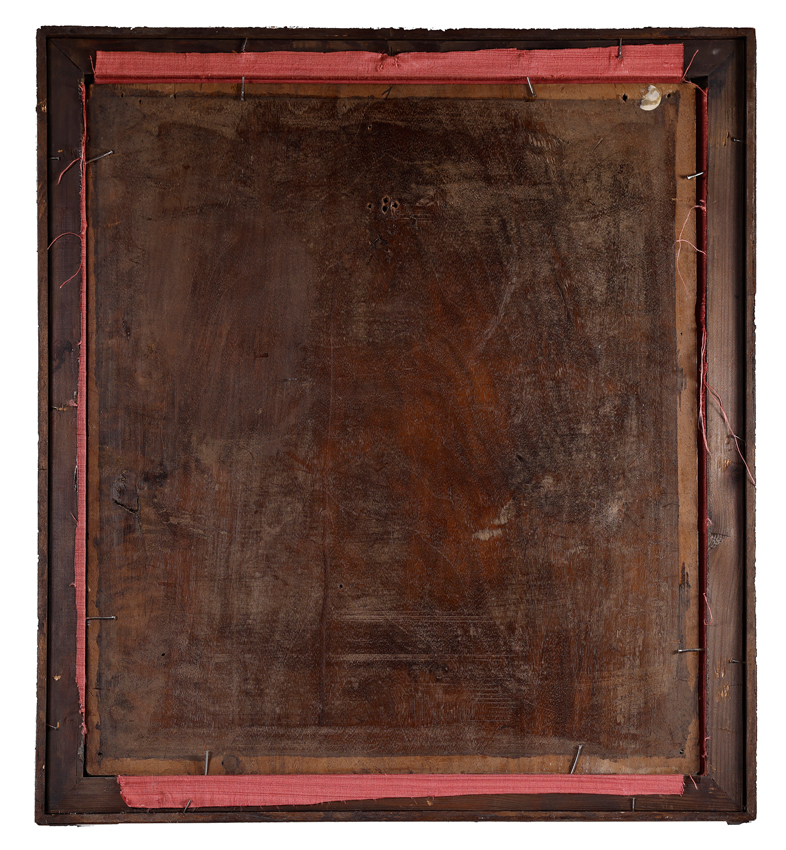16
Castilian school. 16th century.
Castilian school. 16th century.
‘Temperance’ and “Justice”.
Pair of carved, walnut wood reliefs.
47,5 x 42,5 cm. each.
This pair of incredible quadrangular white walnut wood reliefs representing Temperance and Justice must have originally belonged to a liturgical piece of furniture which would also have contained the other two Cardinal Virtues, i.e. Fortitude and Prudence. It is most likely that they were part of a set of Renaissance pews - without categorically ruling out their belonging to a cupboard or a door - as representations of the Virtues were quite common in the pews of this period due to their moralising character, as we must bear in mind that the moral conduct of the Human Being rested on them.
Given the technical characteristics of both reliefs, the remarkable skill and finesse with which they are carved, and the fact that sculpting in walnut and the making of pews and other ecclesiastical furniture were not commissioned from just any master, it seems clear that their sculptor was a relevant sculptor of the Castilian school and that they were carved around the second third of the 16th century.
Both Virtues have been depicted, as is often the case, as women of classical appearance, almost like Roman matrons or noble maidens with sophisticated headdresses. They wear wide, fine garments completely covered with small pleats that make the edges of the garments extremely faceted.The wet cloth technique is simulated in some areas, with which not only the plastic and volumetric values of the reliefs are highlighted but also the voluptuousness of the women, since through these fine garments the rounded forms of their bodies are suggested. As a general rule, they are worked in bas-relief, but in the most relevant areas, such as the heads, hands and attributes, the relief acquires greater volume, close to being in the round, but never quite reaching it.
The heads are small, round and have expressive faces, serious in the case of Justice and more serene in that of Temperance. They have slanting eyes, carved with great detail both in the iris and the eyelids, and above them, sharp curved eyebrows that give them personality, as well as a chiaroscuro in the area of the eye sockets that enhances their volume. The facial features comprise smooth foreheads, broad, elongated noses, marked nasolabial folds, small open mouths with thick lips and bulging cheekbones. The ears are not visible due to the elaborate headdresses that almost completely obscure their hair. In the case of Justice, we can see a scarf that leaves free a couple of snaky locks that slide down her temples, and a ribbon that the anonymous sculptor models with great skill, creating a series of curves and counter-curves while displaying it from different profiles with multiple folds. For her part, Temperance also wears a kind of veil that leaves free a pair of locks of similar characteristics to those of Justice. Above the veil, the end of which seems to be moved by the wind, is a winged head of a putti, one of the most characteristic elements of Renaissance vocabulary. This same putti is found on Justice's neckline, almost like a brooch. Finally, Temperance wears a kind of cloth hanging from the ends of the buckles that cover her ears.
Both women are perfectly identified both by the Latin signs carved on the upper part of the panels - ‘TEMPERATIA’ and ‘IVSTICIA’- and by the attributes they hold in their hands. Thus Justice elegantly holds a scale in her right hand - the allegory of the equality with which she must act - while in her left hand she wields a sword - the symbol of the strength with which she imposes herself - whose long blade occupies the entire height of the panel. Temperance, on the other hand, is seen pouring water from a jug over a wide goblet filled with wine in order to temper what is too stimulating.
The conception of the two figures differs from each other, for while Temperance presents a closed composition, withdrawn in on itself, as well as having a calmer character as it embodies the Virtue it is representing, Justice is conceived with an open composition -see the arms- and shows a more decisive and dynamic spirit. Both differences in state, tranquillity and impetuosity, can be seen in another specific detail that they both share: the way in which the wind moves or waves the scarf or ribbon that covers their hair.
We would like to thank Dr. Javier Baladrón, doctor in Art History, for the identification and cataloguing of this work.
Castilian school. 16th century.
‘Temperance’ and “Justice”.
Pair of carved, walnut wood reliefs.
47,5 x 42,5 cm. each.
This pair of incredible quadrangular white walnut wood reliefs representing Temperance and Justice must have originally belonged to a liturgical piece of furniture which would also have contained the other two Cardinal Virtues, i.e. Fortitude and Prudence. It is most likely that they were part of a set of Renaissance pews - without categorically ruling out their belonging to a cupboard or a door - as representations of the Virtues were quite common in the pews of this period due to their moralising character, as we must bear in mind that the moral conduct of the Human Being rested on them.
Given the technical characteristics of both reliefs, the remarkable skill and finesse with which they are carved, and the fact that sculpting in walnut and the making of pews and other ecclesiastical furniture were not commissioned from just any master, it seems clear that their sculptor was a relevant sculptor of the Castilian school and that they were carved around the second third of the 16th century.
Both Virtues have been depicted, as is often the case, as women of classical appearance, almost like Roman matrons or noble maidens with sophisticated headdresses. They wear wide, fine garments completely covered with small pleats that make the edges of the garments extremely faceted.The wet cloth technique is simulated in some areas, with which not only the plastic and volumetric values of the reliefs are highlighted but also the voluptuousness of the women, since through these fine garments the rounded forms of their bodies are suggested. As a general rule, they are worked in bas-relief, but in the most relevant areas, such as the heads, hands and attributes, the relief acquires greater volume, close to being in the round, but never quite reaching it.
The heads are small, round and have expressive faces, serious in the case of Justice and more serene in that of Temperance. They have slanting eyes, carved with great detail both in the iris and the eyelids, and above them, sharp curved eyebrows that give them personality, as well as a chiaroscuro in the area of the eye sockets that enhances their volume. The facial features comprise smooth foreheads, broad, elongated noses, marked nasolabial folds, small open mouths with thick lips and bulging cheekbones. The ears are not visible due to the elaborate headdresses that almost completely obscure their hair. In the case of Justice, we can see a scarf that leaves free a couple of snaky locks that slide down her temples, and a ribbon that the anonymous sculptor models with great skill, creating a series of curves and counter-curves while displaying it from different profiles with multiple folds. For her part, Temperance also wears a kind of veil that leaves free a pair of locks of similar characteristics to those of Justice. Above the veil, the end of which seems to be moved by the wind, is a winged head of a putti, one of the most characteristic elements of Renaissance vocabulary. This same putti is found on Justice's neckline, almost like a brooch. Finally, Temperance wears a kind of cloth hanging from the ends of the buckles that cover her ears.
Both women are perfectly identified both by the Latin signs carved on the upper part of the panels - ‘TEMPERATIA’ and ‘IVSTICIA’- and by the attributes they hold in their hands. Thus Justice elegantly holds a scale in her right hand - the allegory of the equality with which she must act - while in her left hand she wields a sword - the symbol of the strength with which she imposes herself - whose long blade occupies the entire height of the panel. Temperance, on the other hand, is seen pouring water from a jug over a wide goblet filled with wine in order to temper what is too stimulating.
The conception of the two figures differs from each other, for while Temperance presents a closed composition, withdrawn in on itself, as well as having a calmer character as it embodies the Virtue it is representing, Justice is conceived with an open composition -see the arms- and shows a more decisive and dynamic spirit. Both differences in state, tranquillity and impetuosity, can be seen in another specific detail that they both share: the way in which the wind moves or waves the scarf or ribbon that covers their hair.
We would like to thank Dr. Javier Baladrón, doctor in Art History, for the identification and cataloguing of this work.
Allegories, Legends and Holinesses
Sale Date(s)
Venue Address
General delivery information available from the auctioneer
The purchase price includes the delivery of the lots in the venue of the auction. Transporting to other destinations is at the own risk of the client. The customer must contact "LST", to give the corresponding instructions for such transporting. "LST" is not responsible for the packaging or any accident incurred during transportation.
Important Information
For buyer’s premium and VAT please check particular lot.
Zu Aufgeld und Mehrwertsteuer prüfen Sie bitte das jeweilige Los.
Terms & Conditions
CONDITIONS OF THE AUCTION:
I. REGISTRATION. To bid in the room customers must register at the beginning, filling out a form and picking a number that will identify them during the auction. Customers may be required to register in bank references or other guarantee system and if they do not prove the solvency "LST" will not accept bids and award the auction.
II. WRITTEN BIDS. "LST" will accept written bids, which will be formalized in the form provided by the room until the day before the auction. In such auctions, the room will bid in name of the client until the maximum stated in the offer and always at the lowest possible price. If there are two or more bids for the same amount, the one placed first will have the priority. Written bids received in advance, will have priority on the day of the auction.
III. TELEPHONE BIDS. "LST" will allow telephone bids, if interested people contact "LST" days before the auction providing personal data, ID card and the phone number which will be used by the staff of "LST" to call at the time of the auction. The buyer, within all the legal rights is making an offer for the asking price, when applies for telephone bid. "LST" will not take responsibility for any technical defects beyond its control, which may prevent to contact successfully the bidder during the auction.
IV. AUCTIONEER. The auction will be conducted by an auctioneer, director of the auction will be judge and arbitrator of it with full authority in its development, will award the lots to the highest bidder and is able to settle any controversy concerning lots sale, reject bids, divide lots or group them and remover objects from the room. Will be able to, if it is deemed suitable, not accept bids on the auction. His decision will be unappealable.
V. SALE OF LOTS. The lots are awarded to the highest bidder. Once the auctioneer blows the hammer, the buyer becomes responsible of the lot purchased, exempting "LST" of liability to for any damage and / or accidents that may occur. No refunds of lots.
VI. STARTING PRICE. The amount shown in the catalogue as the starting price for each lot will be, as a rule, the minimum selling price, except for exceptional cases where a reservation may be agreed upon with the seller or it set discretionary by the room.
VII. SCALE OF BIDS. The bids are set according to the following scale:
From 50.-€ to 200.-€…………………………………………..at 10.-€
From 200.-€ to 500.-€…………………………………… …25 in 25.-€
From 500.-€ to 1.000.-€………………………………..…..….50 in 50.-€
From 1.000.-€ to 2.000.-€………………………………..…100 in 100.-€
From 2.000.-€ to 5.000.-€……………………………….….250 in 250.-€
From 5.000.-€ to 10.000.-€…………………………………500 in 500.-€
From 10.000.-€ to 20.000.-€……………………………1.000 in 1.000.-€
From 20.000.-€ to 50.000.-€……………………………2.500 in 2.500.-€
From 50.000.-€ to 100.000.-€…………………………..5.000 in 5.000.-€
From 100.000.-€ to 100.000.-€………………………10.000 in 10.000.-€
From 200.000.-€ to 200.000.-€………………………25.000 in 25.000.-€
From 500.000.-€ to 500.000.-€………………………50.000 in 50.000.-€
VIII. RIGHT OF ADMISION. "LST" reserves the right to admission to the auction room and to reject, at its judgment, any purchase order, from clients whose solvency is not duly proved as well as not to sale auctions.
IX. SALE PRICES. The successful bidder of one or more lots must pay "LST" the final sale price achieves at auction, plus the 24,5 % plus 21% VAT on the commission, at total 29,64% on Hammer Price.
X. CATALOG DATA. The catalogue data are obtained in order to careful research and advice, however, any responsibility is afforded about its accuracy. The lots will be auctioned in the state in which they are, not accepting any claims in restorations, breakage, damage, imperfections and, even description or numbering mistakes in the catalogue, in case of it, being the burden of the buyers to make sure before the auction that the description matches with their personal opinion about respective lot. The exhibition of the lots is intended to allow a perfect review and study of them.
XI. PAYMENT AND REMOVAL OF LOTS. Payment and removal of the lots will be held no later than five days following the auction. After this period expire without having the buyer removed the lot or lots purchases, it will accrue an expense of custody of 6 euros per day on each lot.
15 days after the auction without having the buyer paid and removes the sold lots, "LST" will inform the seller and there will begin judicial proceeding in order to obtain payment. The delay in payment by the purchaser of his/her sold lots will carry an interest increase at a rate of 1,5% per month.
XII. DELIVERY OF LOTS. The purchase price includes the delivery of the lots in the venue of the auction. Transporting to other destinations is at the own risk of the client. The customer must contact "LST", to give the corresponding instructions for such transporting. "LST" is not responsible for the packaging or any accident incurred during transportation.
XIII. RIGHT OF FIRT REFUSAL AND REPURCHASE. "LST" in order to article 38 of "Ley 16/1985 de 25 Junio del Patrimonio Histórico Español" (BOE. 155 June 29, 1985), will notify in advance to the Ministry of Culture, the content of their catalogues. Concerning the lots subject to the legislation referred to in the preceding paragraph, the Administration may exercise the rights of first refusal and repurchase according to the law. "LST" will watch over the protection of Artistic, Historical and Bibliographical Heritage of Spain. For customers out of European Community, a tax for export is required by the Administration.
XIV. VALUE ADDED TAX (I.V.A). This tax will be accrued on commissions of "LST" for buyers, using the rates prevailing on the date of the auction.
XV. DATA PROTECTION. In order to the "Ley 15/1999 de 13 de Diciembre, de Protección de Datos de Carácter Personal", the client authorize "LST", the inclusion of their data in a customer file, and for the promotion by "LST" of the objects at all times the rights of access, rectification or deletion of personal data by sending the appropriate request to the following address: LA SUITE SUBASTAS, C/ Conde Salvatierra, 8, 08006. Barcelona.
XVI. EXPRESS LEGAL JURISDICTION. These Conditions are governed by and interpreted in accordance with the rules of Spanish law. The mere act of participating in the auction as seller, buyer or bidder, implies acceptance of these Terms and Conditions.
Sales operations are understood to be held at the registered office of "LST", C/ Conde de Salvatierra, 8, 08006. Any dispute shall be taken to the competent courts of Barcelona, expressly waiving any other jurisdiction, in accordance with Article 55 of the "Ley de Enjuiciamiento Civil".















